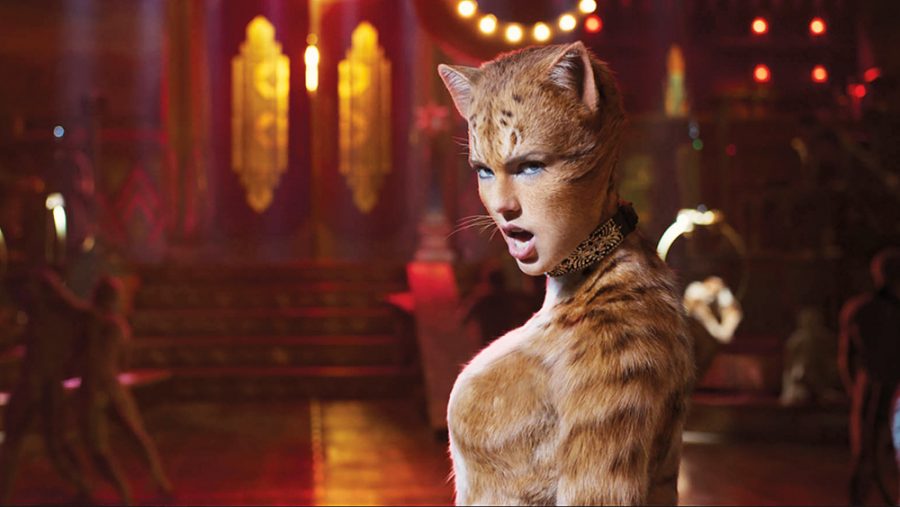Opinion: What Makes a Good Movie Musical
January 14, 2020
As many people know, the movie adaption of the Broadway musical Cats is opening on December 20th, and is causing lots of buzz. The high-budget movie stars Taylor Swift, James Cordon, Rebel Wilson, Jason Derulo, Idris Elba, Judi Dench, Sir Ian McKellen, and Jennifer Hudson, with gorgeous choreography offset by extremely unsettling cat CGI. The trailer for this movie made international news, with millions of people talking about this niche Broadway musical and whether or not this movie is going to be any good. So what does make a good movie adaption of a musical?
Over the last 20 years, there have been lots of adaptations of modern Broadway musicals, with varying degrees of success. Some favorites include movies such as Chicago (2002), Rent (2005), and The Last 5 Years (2014). Some flops include Sweeney Todd (2007), Les Miserables (2012), and, to a degree, Into the Woods (2014). When looking at what made those movies engaging and faithful adaptations, I think of 3 things: choosing the right show (aka. one that makes sense in a movie format), keeping the spirit of the show, and choosing the right people.

The thing about Broadway is that the things that work on a stage do not always work on a screen, and vice versa. There are some stories that work better in a specific medium, which is what a producer has to keep in mind when choosing a Broadway musical to adapt into a movie. This has a lot to do with the setting, the scope of the story, and the reason it was made into a musical. Take for example, the movie adaption of Chicago. Chicago’s musical numbers are a mix of taking place in the “real world”, and in the character’s imagination. This translates well to screen, as the viewer can see a more distinct separation of reality and imagination than they ever could on the stage. There are even some musicals that are improved by the screen, such as Jason Robert Brown’s The Last 5 Years. This musical has a unique storyline, where there are only 2 characters who alternate songs, with one starting at the beginning of the story, and one starting at the end (It makes more sense when you see it). In the stage production, most of the musical is one actor singing alone on stage. However, in the movie version, they are more accurately able to show the passage of time and the interactions of the characters while still maintaining the opposing storylines. An example of a musical that does not work well when translated to the screen is the upcoming movie version of Cats. The whole point of the stage version is that it is actors with cat makeup on, doing gorgeous choreography. It works because nobody is supposed to believe they are cats; it’s about the dancers. In the screen adaption, they go all the way with the cat thing, including hyper-realistic cat CGI that completely defeats the purpose of the musical. Now, people are more focused on the creepy feline people than they are on the actual musical part. It’s important to actually think about the content and structure of the musical, and whether or not a movie adaption would even make sense.

Even if the musical in question does work on paper, there is always the matter of staying true to the source material and soul of the musical. This went glaringly wrong in musicals like Into the Woods, where everything was going great until they decided to cut out large portions of the script, and got rid of one of the main characters (the narrator). Many reviews of the film critiqued the seemingly random plot twists, and how confused some bits made the audience. While the concept of Into The Woods lends itself greatly to the screen, you can’t make a movie with 25% of the plot missing. Another example of this would be Les Miserable. This famous musical was begging for an adaption, and the 2012 film delivered in big ways. Maybe a little too big. They went full out with an enormous budget, giant sets, and sweeping cinematography. The movie went so full out with production value that the character’s singing just seemed like background noise. While a traditional theater’s walls can sometimes be limiting, pushing outside of them so drastically can sometimes make the viewer forget why it worked so well inside those four walls in the first place.

The final and most obvious variable in a movie musical is the cast. Hollywood casting agencies have a tricky tightrope to walk. They have to find a balance of big names that will drive butts into seats, and also finding people who can actually sing and dance. The perfect movie is found when this balance is found. The Rent movie was clever and actually used the original Broadway cast, banking on the popularity of the musical and the success of one Idina Menzel to balance out the seasoned Broadway veterans who had literally invented these characters. But not all movies can afford to cast only Broadway singers, and they make up for it in other ways. The Last 5 Years split it 50/50, with Hollywood A-lister Anna Kendrick performing alongside Broadway star Jeremy Jordan. This is also shown in classical movie musicals, who pretty much banked on Barbara Streissand to carry each and every cast she was put in (and by god she sure did. Take Hello Dolly, Funny Girl, Funny Lady, A Star is Born… and Yentl). But there are some movie musicals who definitely screwed up that equation. Take Sweeney Todd, who did not cast a single musical theater actor in the main cast. The audience had to sit through 2 hours of Johnny Depp singing, between the small reprise of the musical stylings of the Beggar Woman, who was the only actress I could find with legitimate musical experience. This is also reflected in Les Mis, where the unfortunate casting of Russel Crowe as Javert will forever go down in musical theater infamy. Things like this can maybe slide in Mamma Mia!, but not in the complicated and fantastic scores of composers like Sondheim or Andrew Lloyd Webber. Finding actors who can actually sing is the main hurdle of silver screen adaptations.

As you can see, producing a successful movie musical is much more complicated than slapping the stage production onto a screen. These stories started out on stage for a reason, and converting them to another medium takes lots of careful planning. We don’t know yet what is in store for any upcoming major movie musical adaptations. All we can do is hope and pray that the producers do everything in their power to make the movie musical a successful one.

